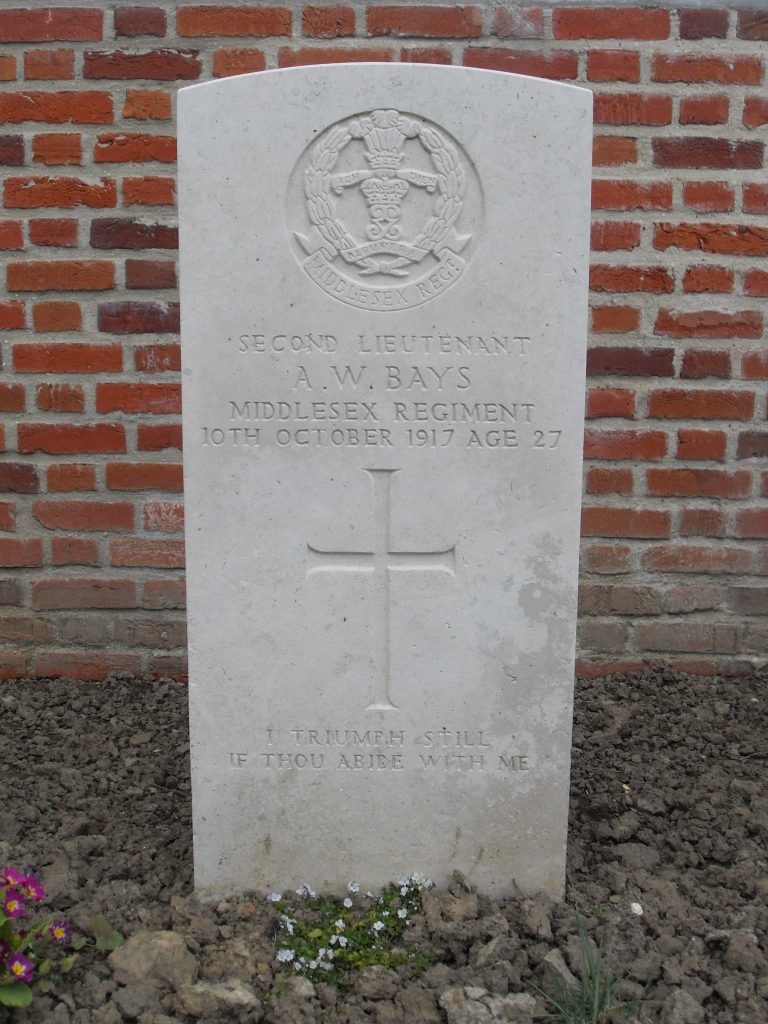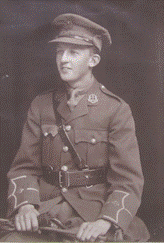Fact file:
Matriculated: Did not matriculate
Born: 27 April 1898
Died: 10 October 1917
Regiment: Middlesex Regiment
Grave/Memorial: Chester Farm Cemetery: III.G.8.
Family background
b. 27 April 1898 in Edmonton as the older child (only son) of Ernest Albert Swallow (1865–1946) and Florence Swallow (née Tuck) (1865–1936) (m. 1891). At the time of the 1901 Census the family was living at 13 Warham Road, Hornsey, London N4 (no servants); by the time of the 1911 Census it had moved to 17 Warham Road, Harringay, London N4, and it was still living there without servants at the time of Swallow’s death.
Parents and antecedents
Swallow’s father was an elementary school teacher; his own father, Peter Swallow (1841–1915), was from Essex but spent most of his life as a waiter in London although retiring to Essex. Swallow’s mother was also an elementary school teacher, although she appears to have stopped teaching when her first child was born. Her father, Frederick Tuck (1842–1895), was a tailor and outfitter in Chatteris, Cambridgeshire, at one time employing ten hands.
Siblings and their families
Swallow’s sister was Edith Ivy (b. 1901); later Houghton after her marriage in 1932 to Wesley Joseph Houghton (b. 1908, d. after 1945); two sons, one daughter. In 1945 the family was living at 41 Bean Road, Bexleyheath, Kent.
“Quando fiam uti chelidon?” (Pervigilium Veneris)
Education
Swallow attended Mattison Road Council School, South Haringay, London N4, from c.1904 to 1910 and then Owen’s College, Islington, from 1910 to 1916, where he was a Foundation Scholar. His record was “one of continual success” and he was considered “probably one of the most brilliant boys” that the school had ever produced. He was an external student at London University’s Faculty of Arts in 1915 and passed the University’s Intermediate Arts Examination with Honours in the same year (2nd Class Honours in English and 2nd Class Honours in History). In December 1915, when he was only 17, he was elected to a History Demyship at Magdalen for October 1916 but did not matriculate. In a letter of 30 October 1917 to President Warren, Swallow’s father wrote that “From the time he won the Demyship […], he continued at Owen’s School reading History, Latin, French & Greek. The last named subject he was studying under the tuition of Mr. Cholmeley.” After his death, someone from Owen’s College wrote to Magdalen:
He was loved in his House, and throughout the School, and earned the respect of all not merely through his literary and artistic talents, but even more because of his cheerful and generous nature and all those other attributes, which go to form the character of an English Gentleman.
War service
Before leaving school in July 1916, Swallow, who was 5 foot 8 inches tall, attested on 5 June 1916, and from 13 July to November 1916 he was a member of the 105th Training Reserve Battalion, part of the Royal Fusiliers’ 29th (Reserve) Battalion, that was stationed in Edinburgh. But because he was not 19 until April 1917, he could not be sent to France, and so, from 1 December 1916 to the end of June 1917, he attended an Officers’ Training Course with No. 8 Officer Cadet Battalion at Lichfield, Staffordshire – although he was in hospital at Lichfield with pleurisy from 22 January to 27 February 1917. In July 1917, he was commissioned in the 6th (Reserve) Battalion of the Middlesex Regiment (The Duke of Cambridge’s Own) (London Gazette, no. 30,160, 29 June 1917, p. 6,532) and was subsequently attached to the Regiment’s 1/4th Battalion (Territorial Force), which had landed at Boulogne on 14 August 1914 as part of 8th Brigade, in the 3rd Division. On 14 November 1915 the Battalion was transferred to the 63rd Brigade, in the 21st Division, and on 8 July 1916, the Battalion, together with the rest of 63rd Brigade was moved to the 37th Division.
Swallow arrived in France on 30 July 1917, and he and two other officers joined the 1/4th Battalion on 7 August 1917, when it was in billets at Dranoutre in southern Belgium. The three men were almost certainly replacements for the eight officers who had been killed in action on 31 July 1917, the date of the opening day of the Third Battle of Ypres (31 July–10 November 1917). Swallow’s Battalion had been involved in the fighting on Kemmel Hill, in the southern sector of the front, east of Oosttaverne Wood and near Wytschaete, four miles south of Ypres, but not in the fighting to the north of Ypres that became known as the Battle of Pilckem Ridge (31 July–2 August 1917). In addition to the eight officers, the 4th Battalion lost 204 other ranks killed, wounded or missing on the day in question.
From 8 to 26 August the Battalion trained in camp at Beaver Corner, and then, on 29 August, i.e. during the lull between the end of the phase of Third Ypres that became known as the Battle of Langemarck (16–18 August) and the beginning of the phase that became known as the Battle of the Menin Road (20–25 September 1917), went into the Reserve trenches at Bois Confluent, south-west of Ypres. It stayed here until 10 September, then trained until 19 September at Mont Kokereele, a 350-foot high hill near the Franco-Belgian frontier, and spent 48 hours gaining experience in the front line before returning to Mont Kokereele for more training from 21 to 27 September, the day after the beginning of that phase of Third Ypres that is known as the Battle of Polygon Wood (26 September–3 October 1917). During this period, from 13 to 29 September, Swallow attended a course at IX Corps Lewis Gun School. From 27 September to 1 October the Battalion was in the front line, after which it spent 48 hours in support at Mount Sorrel, a ridge about two miles east of Ypres.
On 3 October, Swallow’s Battalion was in Reserve when the 8th (Service) Battalion of the Lincolnshire Regiment, with which it was brigaded, moved forward to participate on the following day in the one-day phase of Third Ypres that became known as the Battle of Brodseinde. It was to attack the enemy line that ran northwards from just east of Basseville Beeke, near Zaandvoorde, to south of the Menin Road. Throughout the whole of 4 October, Swallow’s Battalion suffered heavy shelling. After four days resting in camp, the Battalion was taken by bus during the small hours of 10 October 1917 to Shrapnel Corner, one mile south of Ypres on the N365, whence, led by guides, it marched to Canada Tunnels, one mile to the south-east of Zillebeke Lake, with its left flank on the Menin Road, for a five-day stint in the trenches. The Battalion had to make its way to the front along a wooden track that was frequently shelled by enemy artillery, and on this particular night, which was pitch black, it encountered very heavy fire all the way, but especially at Mount Sorrel. Here, a shell fell practically on top of Swallow and his men, and the concussion killed Swallow, aged 19, who was leading his platoon. It also killed Lieutenant Albert William Bays (1890–1917), a baker’s son from Bethnal Green, and six other ranks.
When Swallow’s body was retrieved on 11 October 1917 from beside the track, it had only one small wound but his personal effects were missing. The military authorities made extensive enquiries about their disappearance and did what they could in wartime to locate and retrieve the missing items, but to no avail. Swallow’s family were, however, extremely upset by the loss and what they perceived as the Army’s failure, and for several months they continued to send very angry letters to people who they thought might be able to assist them in their search. On 29 December 1917 Swallow’s father wrote a letter to the War Office in which he threatened to bring the matter before the Army Council and stated that “in any case I have no intention of letting the matter drop”. He kept his word, but with no result, and finally, on 12 February 1918, he said the following with understandable bitterness in a letter to his MP, Mr Kennedy Jones, a Scottish newspaper manager (1865–1921; Conservative MP for Hornsey 1916–21): “My son, who was a Demy of Magdalen College Oxford[,] gave up a brilliant career to fight and die for his King and Country and this is the reward of his sacrifice.” The letter found its way to the War Office and is now in Swallow’s personal file in the National Archives. He and Lieutenant Bays are buried in Chester Farm Cemetery (south of Ypres), Graves III.G.8 (inscribed “Demy of Magdalen College, Oxford. Called to Higher Service”) and III.G.4 (inscribed “I triumph still if Thou abide with me”) respectively; Swallow is commemorated on a memorial that stands in the grounds of Owen’s College.
Swallow’s father continued his letter to President Warren of 30 October 1917 as follows:
he had only been out about 10 weeks when he was killed. He was always thinking of the time when this awful war would be over and he would enter on his career at Oxford. Of a gentle and studious nature he had no leaning towards a military career, and nothing but a deep sense of duty enabled him to reconcile himself to a soldier’s life. When, however, he became convinced that he ought to answer his country’s call he strove, as he did in all else, to make himself thoroughly efficient. We cannot believe that a life of such high promise is ended, but that He who gave it has, in his wisdom, called him to higher service.
And an obituarist writing in the School Magazine echoed these sentiments as follows:
Of the many boys who have passed through Owen’s [School] there has been no-one who has displayed a more cheerful zeal for everything that he undertook than E.H. Swallow. When he entered the Army he showed exactly the same characteristics. Although he was one of the most gentle of boys, and so one of the last whom one would expect to take any pleasure in a soldier’s life, he did his utmost to acquire a thorough grasp of military affairs in order that he might become an efficient officer. He had an intense love of his old school, and his one abiding ambition was to have acquitted himself at Oxford so as to have brought honour to Owen’s School.
Bibliography:
For the books and archives referred to here in short form, refer to the Slow Dusk Bibliography and Archival Sources.
Archival sources:
MCA: Ms. 876 (III), vol. 3.
MCA: PR 32/C/3/1115–1116 (President Warren’s War-Time Correspondence, Letters relating to E.H. Swallow [1915–1917]).
WO95/2528.
WO339/76707.



